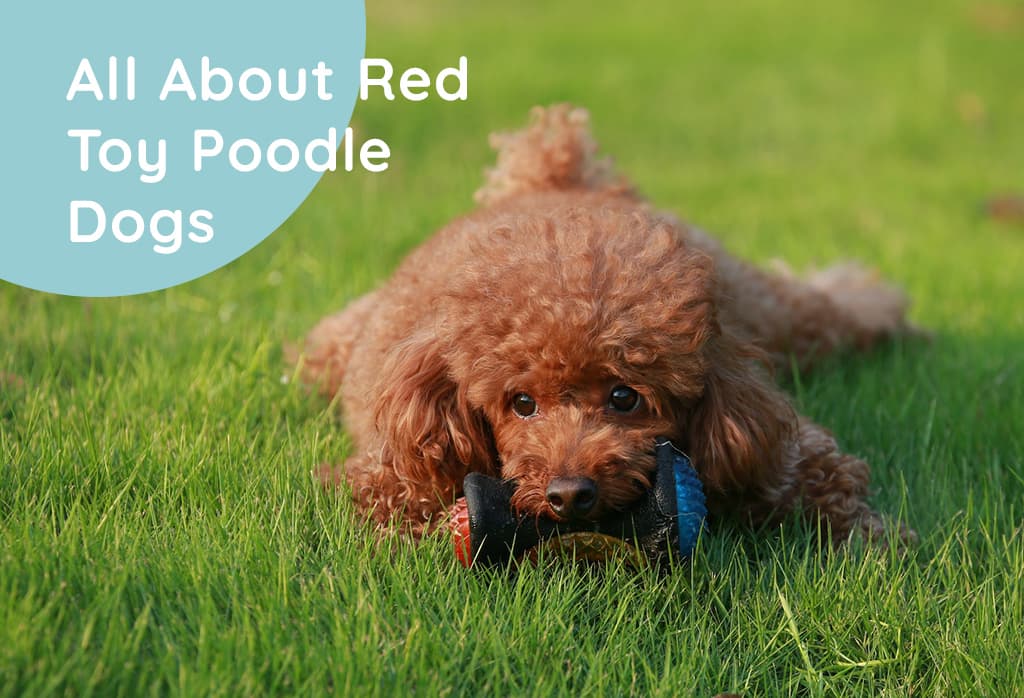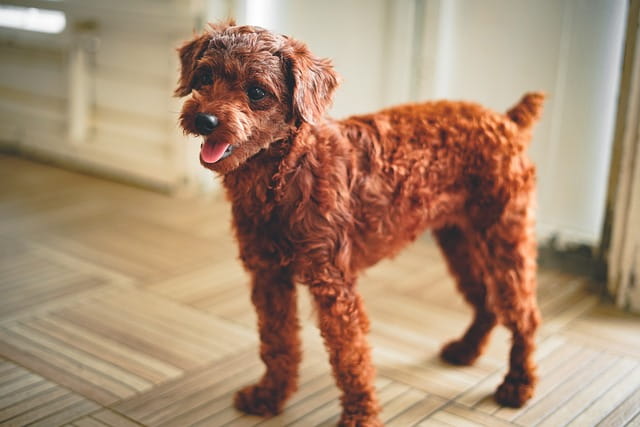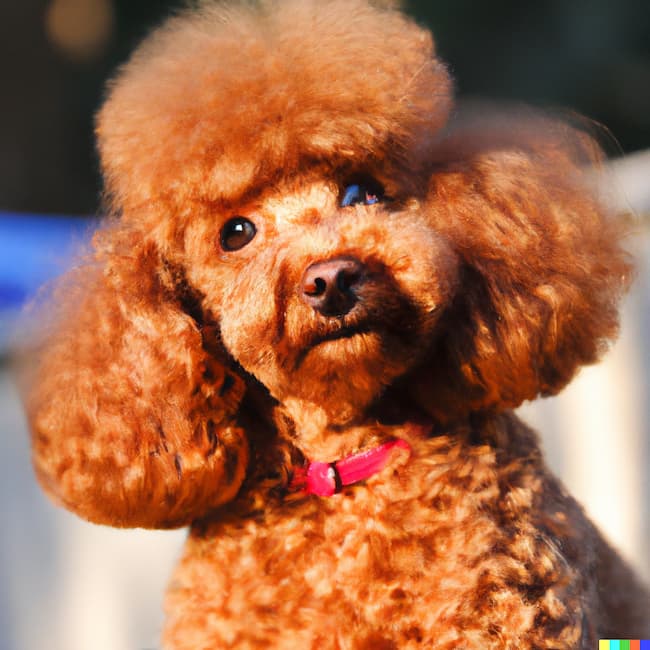A red toy poodle is a small dog breed that is characterized by its reddish-brown or reddish-orange color.
Toy poodles are a miniature version of the standard poodle breed and are known for their intelligence, playfulness, and affectionate nature.
They are typically between 10 and 15 inches tall at the shoulder and weigh between 4 and 6 pounds.
Toy poodles are popular pets and are often trained to compete in obedience and agility trials.
Origin
Like all toy poodles, red toy poodles are descended from the standard poodle breed.
The standard poodle is a medium-sized dog that originated in Germany and was used as a hunting dog.
Over time, the standard poodle was bred in smaller sizes, resulting in the toy poodle breed.
Toy poodles were first bred in France, where they were popular among the nobility as companion dogs.
They were prized for their intelligence, playful nature, affectionate disposition, and stylish and elegant appearance.
Red toy poodles are a color variation of the toy poodle breed.
The specific color of a toy poodle is determined by its genes, and red toy poodles may have inherited their reddish-brown or reddish-orange color from their parents.
Today, red toy poodles are popular pets all over the world, and they are often used in dog shows and competitions.
Temperament
Toy poodles are generally known for their intelligence, playful nature, and affectionate disposition.
They are energetic and playful but can also be calm and gentle.
They are intelligent and easy to train and often used as service dogs or therapy dogs because of their good temperaments.
Toy poodles are also loyal and protective of their owners and generally good with children and other pets.
They can be wary of strangers, but they are not aggressive.
Overall, toy poodles are gentle, loving, and friendly dogs that make great companions.
Health issues
Like all toy poodles, red toy poodles may be prone to certain health conditions.
Some of the most common health issues for toy poodles include:
Luxating patella
This is a condition in which the kneecap becomes dislocated or slips out of place. It can cause pain, lameness, and mobility issues in toy poodles.
Hip dysplasia
This is a condition in which the hip joint does not develop properly, causing pain and discomfort. It can be inherited or caused by environmental factors, and it is more common in larger dog breeds.
Tracheal collapse
This is a condition in which the trachea (windpipe) becomes weak and collapses, causing difficulty breathing. It is more common in small dog breeds, such as toy poodles.
Epilepsy
This is a neurological disorder that causes seizures. It can be inherited or acquired, and it can be challenging to treat.
Progressive retinal atrophy
This degenerative eye disease can cause vision loss and blindness. It is more common in older toy poodles.
Red toy poodles may also be prone to other health issues, such as dental problems, skin allergies, and ear infections.
It is important to provide regular veterinary care and to monitor your toy poodle for any signs of health problems.
Identifying and treating health issues early can help your toy poodle live a long and healthy life.
Grooming
Red toy poodles, like all toy poodles, require regular grooming to maintain their health and appearance.
Toy poodles have thick, curly coat that can easily become matted if it is not groomed regularly.
To properly groom a toy poodle, you should:
Brush the coat daily
Use a slicker brush or a comb to brush your toy poodle’s coat every day. This will help remove tangles and mats, and it will distribute the natural oils in the coat.
Trim the coat regularly
Toy poodles should be professionally groomed every 4-6 weeks to keep their coats looking neat and tidy. During a grooming session, the groomer will trim the coat, clip the nails, clean the ears, and perform a thorough health check.
Bathe your toy poodle regularly
Toy poodles should be bathed every 2-3 months, using a mild shampoo specifically designed for dogs. Avoid using human shampoos, as they can be harsh and drying on a dog’s skin.
Check the ears regularly
Toy poodles are prone to ear infections, so it is important to check their ears regularly for any signs of infection, such as redness, swelling, or discharge.
If you notice any of these signs, contact your veterinarian for treatment.
By following these grooming tips, you can help keep your toy poodle’s coat and skin healthy, and you can prevent common health issues.
Training
Red toy poodles are intelligent and eager to please, which makes them relatively easy to train.
Toy poodles are often trained to compete in obedience and agility trials, and they are also often used as service dogs or therapy dogs because of their intelligence and adaptability.
To train a red toy poodle, it is important to use positive reinforcement techniques, such as rewards and praise.
This will help your toy poodle learn faster and more effectively, and it will also help build a strong bond between you and your dog.
When training a red toy poodle, patience and consistency are also important.
Toy poodles can be independent and stubborn and may not always respond to the training immediately.
By being patient and consistent, you can help your toy poodle learn new commands and behaviors more quickly and effectively.
To begin training a red toy poodle, start with simple commands, such as “sit,” “stay,” and “come.”
Once your toy poodle has mastered these basic commands, you can move on to more advanced training, such as agility training or obedience training.
By providing regular training and socialization, you can help your red toy poodle become a well-behaved and well-rounded dog.
Are red Toy Poodles rare?
Red toy poodles are not particularly rare.
In fact, they are one of the most common color variations of the toy poodle breed.
Toy poodles can come in a wide range of colors, including black, white, cream, apricot, red, and silver.
The specific color of a toy poodle is determined by the genes it inherits from its parents.
Some color variations, such as red, may be more common than others, but overall, toy poodles of all colors are relatively common.
How much is a red toy Poodle?
The price of a toy red poodle can vary depending on several factors, such as the dog’s age, pedigree, and health.
On average, toy red poodles can cost between $500 and $1500.
However, some toy red poodles may be more expensive, depending on their breeding and show quality.
It is important to do research and compare prices from different breeders before purchasing a toy red poodle.
It is also important to ensure that the breeder is reputable and that the puppy is healthy and well-cared for.
How long do red Toy Poodles live?
The average lifespan of a toy poodle, regardless of its color, is between 10 and 18 years.
This is longer than the lifespan of many other small dog breeds, and it is due in part to the toy poodle’s intelligence and adaptability.
Toy poodles are generally healthy dogs, but they can be prone to certain health conditions, such as luxating patella, hip dysplasia, and tracheal collapse.
It is important to provide regular veterinary care and a healthy diet to help ensure that a toy poodle lives a long and happy life.









